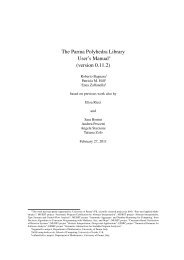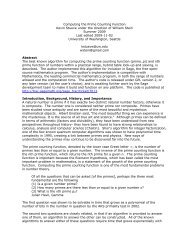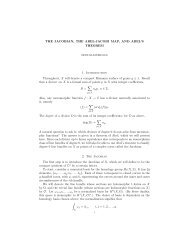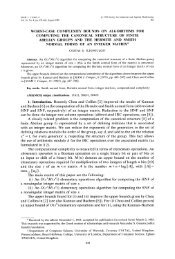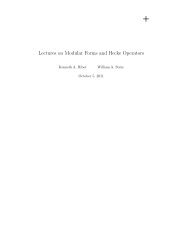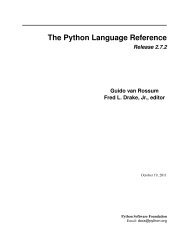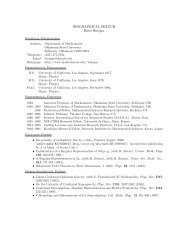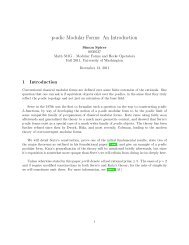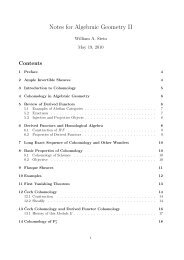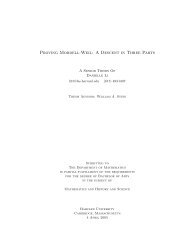Efficient implementation of the Hardy-Ramanujan ... - William Stein
Efficient implementation of the Hardy-Ramanujan ... - William Stein
Efficient implementation of the Hardy-Ramanujan ... - William Stein
Create successful ePaper yourself
Turn your PDF publications into a flip-book with our unique Google optimized e-Paper software.
IMPLEMENTATION OF THE HRR FORMULA Page 9 <strong>of</strong> 19<br />
To make Theorem 4 effective, we can use m ≤ log 2 k and bound |t k | a priori using (1.8) with<br />
N = k, or simply inspect <strong>the</strong> parameters in (3.2) for a given term.<br />
Naturally, for n ≤ 2000, <strong>the</strong> same precision bound can be verified to be sufficient through<br />
direct computation. We can even reduce overhead for small n by using a tighter precision,<br />
say r = |t k |+O(1), up to some limit small enough to be tested exhaustively (perhaps much<br />
larger than 2000). The requirement that r > 1 2 log 2n+O(1) always holds in practice if we set<br />
a minimum precision; for n feasible on present hardware, it is sufficient to never drop below<br />
IEEE double (53-bit) precision.<br />
3.2. Computational cost<br />
We assume that r-bit floating-point numbers can be multiplied in time M(r) =<br />
O(rlog 1+o(1) r). It is well known (see [BZ11]) that <strong>the</strong> elementary functions exp, log, sin<br />
etc. can be evaluated in time O(M(r)logr) using methods based on <strong>the</strong> arithmetic-geometric<br />
mean (AGM). A popular alternativeis binarysplitting, which typically has cost O(M(r)log 2 r)<br />
but tends to be faster than <strong>the</strong> AGM in practice.<br />
The <strong>Hardy</strong>-<strong>Ramanujan</strong>-Rademacher formula contains O(n 1/2 ) terms, where <strong>the</strong> kth term<br />
needs to be evaluated to a precision <strong>of</strong> O(n 1/2 /k)+O(logn) bits and can be written as a<br />
product<strong>of</strong>O(logk)factors.Usinganycombination<strong>of</strong>O(M(r)log α r) algorithmsforelementary<br />
functions, <strong>the</strong> complexity <strong>of</strong> <strong>the</strong> numerical operations is<br />
⎛<br />
n∑<br />
1/2 ( )<br />
O⎝<br />
n<br />
1/2<br />
logk M<br />
k<br />
k=1<br />
log α n 1/2<br />
k<br />
⎞<br />
⎠ = O<br />
( )<br />
n 1/2 log α+3+o(1) n<br />
(3.12)<br />
which is nearly optimal in <strong>the</strong> size <strong>of</strong> <strong>the</strong> output. Combined with <strong>the</strong> cost <strong>of</strong> <strong>the</strong> factoring<br />
stage, <strong>the</strong> complexity for <strong>the</strong> computation <strong>of</strong> p(n) as a whole is <strong>the</strong>refore, when properly<br />
implemented, s<strong>of</strong>tly optimal at O(n 1/2+o(1) ). From (3.12) with <strong>the</strong> best known complexity<br />
bound for elementary functions, we obtain:<br />
Theorem 5. The value p(n) can be computed in time O(n 1/2 log 4+o(1) n) (with <strong>the</strong><br />
assumption in Theorem 1).<br />
A subtle but crucial detail in this analysis is that <strong>the</strong> additions in <strong>the</strong> main sum must be<br />
implemented in such a way that <strong>the</strong>y have cost O(n 1/2 /k) ra<strong>the</strong>r than O(n 1/2 ), since <strong>the</strong> latter<br />
would result in an O(n) total complexity. If <strong>the</strong> additions are performed in-place in memory,<br />
we can perform summations <strong>the</strong> natural way and rely on carry propagation terminating in an<br />
expected O(1) steps, but many<strong>implementation</strong>s<strong>of</strong>arbitrary-precisionfloating-pointarithmetic<br />
do not provide this optimization.<br />
One way to solve this problem is to add <strong>the</strong> terms in reverse order, using a precision that<br />
matches <strong>the</strong> magnitude <strong>of</strong> <strong>the</strong> partial sums. Or, if we add <strong>the</strong> terms in forward order, we can<br />
amortize <strong>the</strong> cost by keeping separate summation variables for <strong>the</strong> partial sums <strong>of</strong> terms not<br />
exceeding r 1 ,r 1 /2,r 1 /4,r 1 /8,... bits.<br />
3.3. Arithmetic <strong>implementation</strong><br />
FLINT uses <strong>the</strong> MPIR library, derived from GMP, for arbitrary-precision arithmetic, and<br />
<strong>the</strong> MPFR library on top <strong>of</strong> MPIR for asymptotically fast arbitrary-precision floating-point<br />
numbers and correctly rounded transcendental functions [MPIR, GMP, MPFR]. Thanks to<br />
<strong>the</strong> strong correctness guarantees <strong>of</strong> MPFR, it is relatively straightforward to write a provably<br />
correct <strong>implementation</strong> <strong>of</strong> <strong>the</strong> partition function using Theorem 4.



